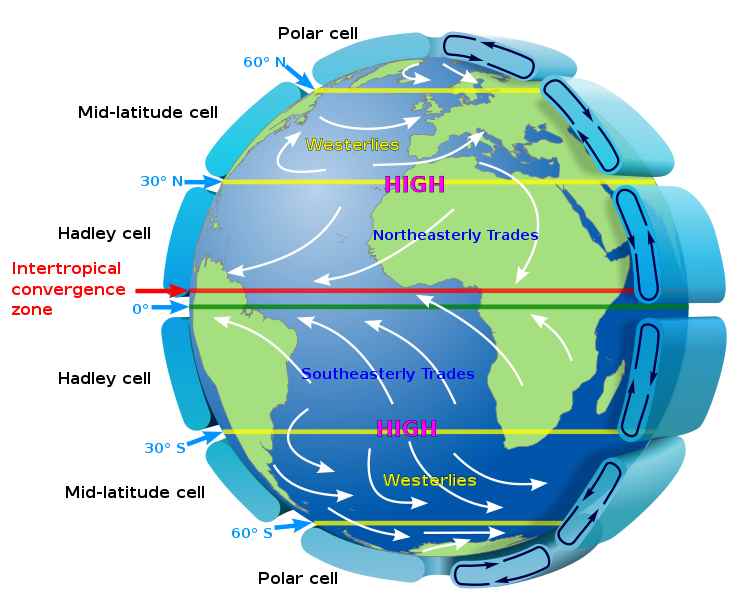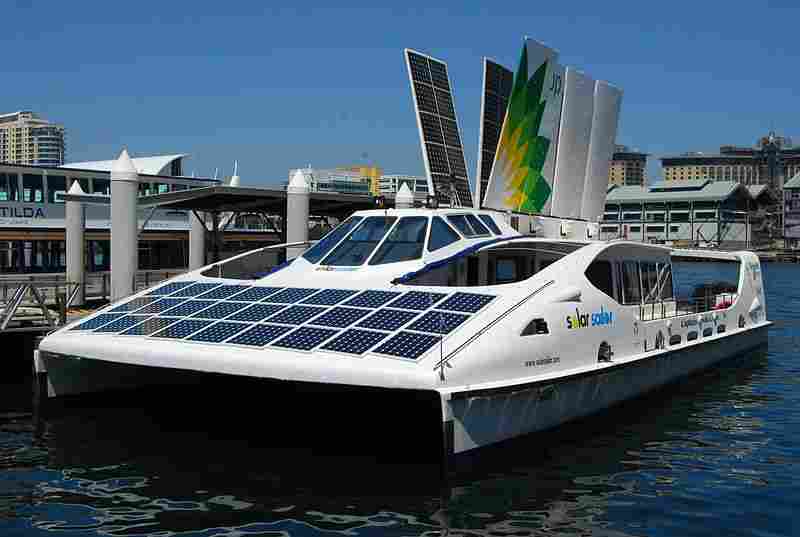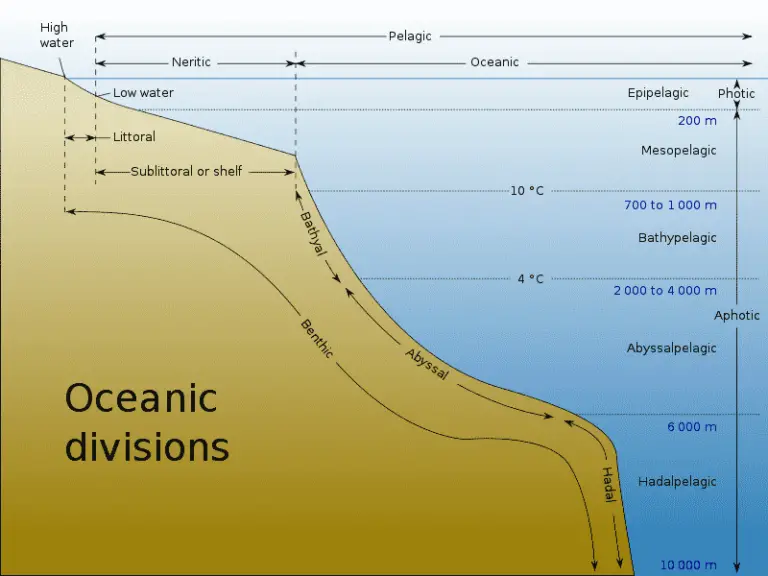5 Tropical Rainforest Climate Characteristics Discussed
Tropical rainforest climate is characterized by; abundant rainfall, solar radiation, high relative-humidity, warm temperature, and relatively-high atmospheric pressure.
This article discusses the tropical rainforest climate based on its major elements, as follows;
1). Precipitation in the Tropical Rainforest (as one of the Characteristics of Tropical Rainforest Climate)
One of the core attributes of tropical rainforest climate is high amounts of precipitation, all year-round.
In fact, high precipitation is such a prominent characteristic of the rainforest that it is featured in the name of this ecosystem, which describes a forest with abundant rain.
Annual rainfall in the tropical rainforest ranges from 1,800 to 10,000 millimeters on average [4]. Climatic conditions are generally stable, so that tropical rainforests receive relatively equal amount of rainfall at all times of the year; which could be in the form of drizzles or heavy downpours with thunderstorms.
As a result of the intensity and consistency of rainfall in tropical rainforests, there is no intense dry season or distinct tendency of dryness. The only variations are in the monthly intensity of rainfall, and these are minor compared to seasonal weather changes in other ecosystems.
Factors influencing the climate of tropical rainforests in terms of precipitation include; topography and inter-tropical convergence.
The Inter-Tropical Convergence Zone (ITCZ) is close to the equator and serves as a meeting-point for northern and southern trade winds [2]. This zone coincided with many tropical forests of the world, so that the trade wind-dynamics plays a role how rain-clouds are formed.
Rainfall is crucial to the efforts at identifying and distinguishing seasons in the tropical rainforest.
Seasons in a tropical rainforest are; wet and dry seasons respectively, each of which is believed to last for approximately six months.
As earlier stated; the dry season is not prominent, or even very distinctive, in a tropical rainforest.
The period(s) described as 'dry season' in a tropical rainforest is simply any period with less rainfall than average. Reductions in amount of rainfall are generally minor, meaning that dry seasons are still essentially humid.
The wet season in a tropical forest, on the other hand; is characterized by peak levels of precipitation and humidity.
Precipitation is the main mechanism by which water is supplied to rainforest soil, vegetation, organisms, and micro-habitats like aquatic ecosystems (including lakes and ponds in the rainforest). Water is itself an essential abiotic factor in the rainforest, that plays a role in its sustainability, biodiversity and species-richness.

2). Solar Radiation in the Tropical Rainforest
Solar radiation is an important element of tropical rainforest climate, and strongly influences other elements like temperature, precipitation, atmospheric pressure and humidity.
The importance of solar radiation transcends climatic contexts. It is the ultimate source of energy to the rainforest, and the precursor to essential resources like biomass and bioenergy, that are recycled across the trophic levels of the forest food chain.
Solar radiation can be described as electromagnetic waves from the Sun, that contain thermal and light energies in the form of infrared and visible light rays, respectively.
The thermal energy in solar radiation affects rainforest temperature. It can be stored by plant leaves in the dense forest canopy, and accounts for the relative-warmth of rainforests.
Air masses are also heated by solar radiation, thereby creating convective cycles of low and high-density air that contribute to precipitation and humidity.
Microclimates are established by solar irradiance in sections of the tropical forest [1]. This is because of the partial shade created by vegetation and the manner in which the rainforest canopy intercepts and obstructs solar beams from reaching the forest floor.
Sections of the forest with higher solar penetration will experience warmer micro-climates than areas with less radiation. Other climatic elements like humidity and air pressure will also vary between these micro-climatic zones.
Asides being an element of climate, solar radiation influences the growth, distribution and adaptation of all rainforest plants, as well as the metabolic efficiency, population size, species-richness, biodiversity, and adaptation(s) of animals in the rainforest.

3). Humidity in the Tropical Rainforest (as one of the Characteristics of Tropical Rainforest Climate)
Humidity is generally high in the tropical rainforest, and this is in part responsible for the abundance of thriving vegetation, microbes and animals.
In turn, rainforest abiotic and biotic components, play a role in the high-humidity condition.
For example, evapotranspiration from soil, leaves, and water bodies releases moisture into the air to increase humidity. Evapotranspiration is especially effective at establishing humid conditions in the tropical rainforest, because of the abundance of vegetation.
The dense nature of forest vegetative-canopies reduced the rate at which moisture is lost to the upper-atmosphere, by trapping most of this moisture between the canopy and the forest floor.
Many forest plants also have tissues, coatings, thick outer-layers, and other adaptive features for water conservation; that enable these plants absorb water and contribute to the humidity of their surroundings.
Mist and fog occur in tropical rainforest zones [6]. They form by the interaction of warm, moist and cooler air masses; and they are indicative of the humidity of their environment.
4). Temperature in the Tropical Rainforest
All year-round, the tropical rainforest experiences relatively-high temperature with minimal periodic variation.
The temperature of tropical rainforests ranges from 25-30°C, with an absolute average of about 25°C [3]. While there are fluctuations in the absolute value of temperature with time, on a broad scale, these fluctuations are almost negligible, and play no role in establishing any distinctive, seasonal weather changes.
Diurnal changes in temperature between nighttime and daytime values is also minimal, hardly reaching 10°C.
The reason for the warm, relatively-stable weather conditions in tropical rainforests is a myriad factors.
One of these is the dense pattern of vegetation growth, that causes the forest canopy to trap and retain both moisture and heat.
Another reason is the geographic location of tropical rainforests, which is close to the equator; a zone with consistent, high solar radiation and minimal changes in intensity.
In most tropical rainforests, temperature decreases downward across a vertical thermal-gradient. This is because the higher levels of the canopy receive and retain most of the incident solar radiation, with less and less of solar thermal energy reaching the lower levels.
Humidity and clouding are also often cited as contributors to the warm nature of tropical rainforests, because of the ability of atmospheric water droplets to act as an energy storage-medium for heat.
5). Atmospheric Pressure in the Tropical Rainforest (as one of the Characteristics of Tropical Rainforest Climate)
The local atmospheric pressure in tropical rainforests is relatively high, especially in comparison to other ecosystems. This differs from the atmospheric pressure close at the equator and in areas surrounding the tropical rainforest, which is generally low.
Atmospheric pressure can be defined as the force which air masses exert on a given area by reason of their gravitational weight.
It is important to note the distinction between local and regional atmospheric pressure when discussing tropical rainforest climate, because there are several studies describing atmospheric pressure in the tropics and equatorial zone as being low. This is in fact correct, but it differs from atmospheric pressure within the tropical rainforest itself, which is not strongly influenced by regional conditions but has its own micro-climate.
At the equator and in the Inter-Tropical Convergence Zone (ITCZ), atmospheric pressure is low close to the Earth's surface, because solar heating of air masses causing them to lose their density and rise, in a continuous convective dynamic with low pressure always occurring in warm, less-dense air close to the ground [5].
On the other hand, in the tropical rainforest, although air masses are being constantly warmed, the rate and effectiveness with which they rise to create low-pressure conditions close to the ground, are low. This can be attributed to the fact that the forest canopy and dense vegetation in the understory, limit air movement.
As a result, there is a less-active cycle of air masses within the rainforest, and the stratified air column exerts significant force on the ground.
Generally, the atmospheric conditions in tropical rainforests are stable with minimal air-mixing and circulation. However, this does not create anoxic conditions because oxygen is constantly being produced through photosynthesis, by the abundant vegetation.

Conclusion
Tropical rainforest climate characteristics are;
1. Abundant Rainfall
2. Solar Radiation
3. High Relative-Humidity
4. Temperature
5. Atmospheric Pressure
References
1). Graham, E. A.; Hansen, M.; Kaiser, W. J.; Lam, Y.; Yuen, E.; Rundel, P. W. (2021). "Dynamic Microclimate Boundaries across a Sharp Tropical Rainforest-Clearing Edge." Remote Sensing 13(9). Available at: https://doi.org/10.3390/rs13091646. (Accessed 2 June 2023).
2). Grodsky, S. A.; Carton, J. (2003). "The Intertropical Convergence Zone in the South Atlantic and the Equatorial Cold Tongue." Journal of Climate 16(4):723-733. Available at: https://doi.org/10.1175/1520-0442(2003)016<0723:TICZIT>2.0.CO;2. (Accessed 2 June 2023).
3). Kastolani, W. (2018). "How to Conservate in Situ and Ex Situ Community Based Biodiversity Park in Sumedang Regency of West Java Province?" IOP Conference Series Earth and Environmental Science 145(1):012091. Available at: https://doi.org/10.1088/1755-1315/145/1/012091. (Accessed 2 June 2023).
4). Quinto, H.; Moreno, F. (2015). "Precipitation effects on soil characteristics in tropical rain forests of the Chocó biogeographical region." Revista Facultad Nacional de Agronomía Medellín 69(1):7813-7823. Available at: https://doi.org/10.15446/rfna.v69n1.54749. (Accessed 2 June 2023).
5). Waliser, D. E.; Jiang, X. (2014). "Tropical Meteorology and Climate: Intertropical Convergence Zone." Available at: https://doi.org/10.1016/B978-0-12-382225-3.00417-5. (Accessed 2 June 2023).
6). Zhang, Y.; Liu, Y.; Li, H. (2004). "Water input from fog drip in the tropical seasonal rain forest of Xishuangbanna, South-West China." Journal of Tropical Ecology 20(05):517 - 524. Available at: https://doi.org/10.1017/S0266467404001890. (Accessed 2 June 2023).










